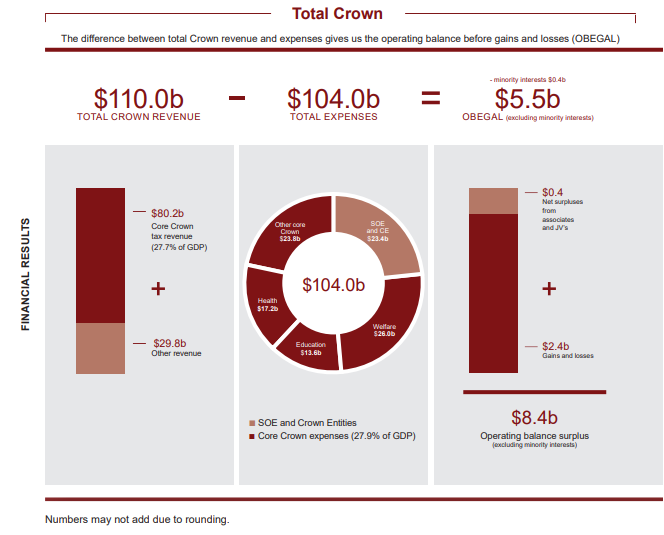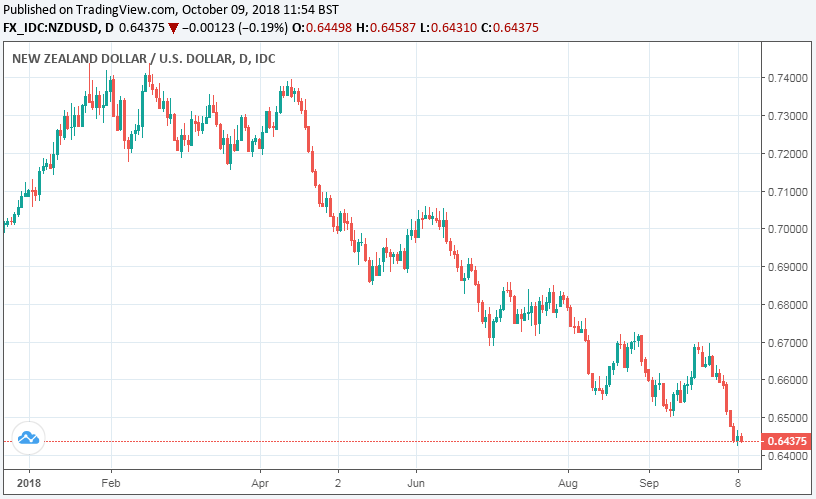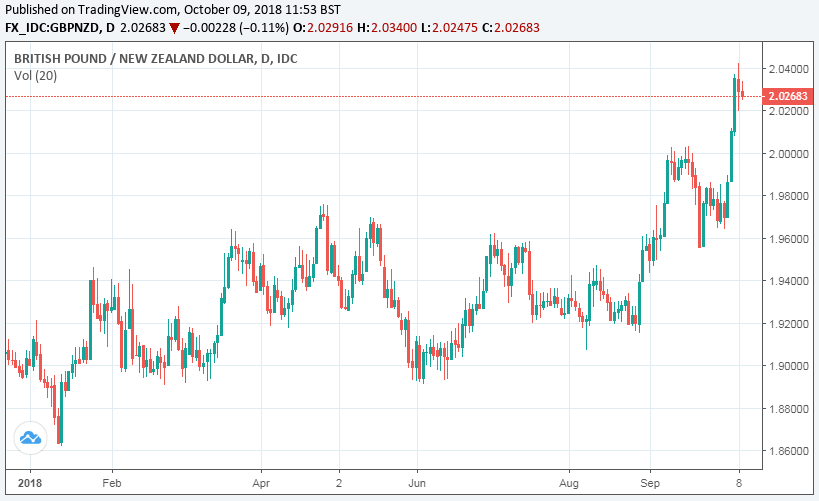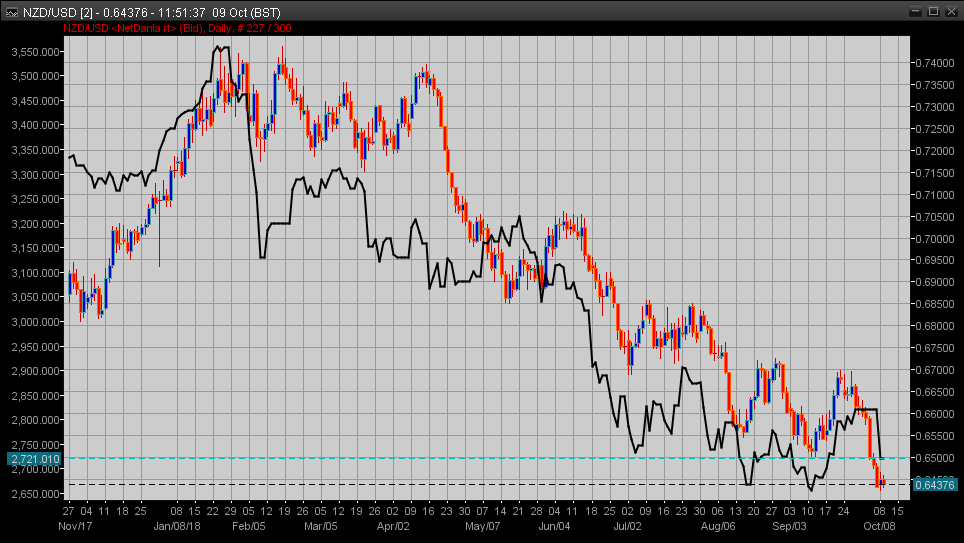New Zealand Dollar Heads for Fresh Lows as J.P. Morgan Warns of More Losses to Come
- Written by: James Skinner

Image © Adobe Stock
- NZD falls despite government's posting larger budget surplus.
- Budget data confirms economy in good shape but NZD extends losses.
- J.P. Morgan forecasts crisis-era lows as risk environment deteriorates.
The New Zealand Dollar fell to new lows Tuesday despite official data casting the government's financial books in a more favourable light than previously thought, emphasising the extent to which the Kiwi is being driven by an unsupportive global environment.
New Zealand's government ran a larger-than-expected budget surplus for the year to the end of June 2018, according to data released this week, with the operating balance before gains and losses coming in at $5.5 billion. This is up $1.5 billion from the previous year and ahead of government forecasts.
Higher than expected tax revenues as well as lower government spending were the main drivers behind the surplus. Lower spending was largely the result of delays to government projects that will soon be unwound but the better tax revenues resulted from the economy's resilient performance over the last year according to the Treasury.

Above: Government of New Zealand budget balance. Source: Treasury of New Zealand.
"The stronger than expected starting point provides some leeway if economic growth fails to live up to the Treasury’s upbeat forecasts. It also implies that in upcoming fiscal updates the Government could announce even more stimulus for the economy than is already planned," says Michael Gordon, an economist at Westpac.
This latter development flies in the face of much of the recent data emerging from the New Zealand economy, which has shown business confidence falling to a post-crisis low in response to the new Labour-led government's policy agenda.
That decline, alongside persistent below-target inflation, has had currency markets fearing a rate cut from the Reserve Bank of New Zealand (RBNZ) this year, which explains a sizeable portion of the Kiwi's losses for 2018.
"This continues the theme of the big difference between "soft data" such as recessionary business confidence and activity, and surging "hard data" such as revenue growth and strong Q2 GDP. The economy is in good shape, but confidence continues to reflect a prolonged complaint against the Labour-led government," says Annette Beacher, chief Asia Pacific macro strategist at TD Securities.
The government financial statements should have been good for the New Zealand Dollar as they indicate the economy is not nearly as troubled as markets perceive and highlight clear scope for the government to splash out on stimulus should growth falter further down the line.
However, the Kiwi has overlooked the brighter domestic details and is still taking its cues from events in the offshore space given the extent to which the Reserve Bank of New Zealand has sidelined the domestic story.

Above: NZD/USD rate shown at daily intervals.
The NZD/USD rate was quoted 0.20% lower at 0.6434 Tuesday, its lowest level since January 2016, although the Pound-to-New-Zealand-Dollar rate was down 0.06% at 1.2.0282, denoting a weaker Sterling.

Above: Pound-to-New-Zealand-Dollar rate shown at daily intervals.
RBNZ governor Adrian Orr told markets its interest rate is likely to remain at the current record low of 1.75% through 2019 and into 2020 back in September. And other RBNZ staff have said the odds of a rate cut have risen this year, prompting market speculation about the possibility of a policy change.
With interest rates elsewhere in the world now rising, this has left traders with little reason to hold the New Zealand Dollar at a time when it is under mounting pressure due to the effect President Donald Trump's trade war with China is having on so called risk assets like the Kiwi, Australian Dollar and global stocks.
Price action this week has already left the New Zealand Dollar trading close to a three-year low but strategists at J.P. Morgan are warning there are more losses to come now the Kiwi has broken below a key technical threshold and the offshore environment is becoming ever more unsupportive of risk assets.
"The already well developed downtrends in AUD/USD and in NZD/USD received an additional push via the latest down-reversal’s in leading risk markets like the S&P 500," says Thomas Anthonj, a strategist at J.P. Morgan. "We expect this down-consolidation to drag on for most of October, if not into November, before the classical year-end rally could unfold."

Above: NZD/USD and Shanghai Composite Index (Black). Source: Netdania Markets.
Global stock markets have turned lower in the last week as rising U.S. interest rates and the President Trump's trade war with China finally make a dent in investors' optimism about the outlook for corporate earnings the world over.
Trump has imposed tariffs on more than $250 billion of Chinese goods imported into the U.S. each year and is threatening to target a further $260 billion.
This could eventually hurt Chinese exports to the rest of the world as well as growth in the world's second largest economy.
New Zealand's Dollar is is underwritten by the nation's agricultural commodity trade with China and so it is sensitive to changes in sentiment toward the Chinese economy, which are heavily influenced by expectations for global growth.
"It remains likely that key-supports at 0.7030 in AUD/USD and at 0.6450 in NZD/USD are broken, which would give room to challenge old lows from 2016/2015 at 0.6827 (AUD/USD) and at 0.6236 (NZD/USD)," says Anthonj, in a note to clients.
Advertisement
Get up to 5% more foreign exchange by using a specialist provider to get closer to the real market rate and avoid the gaping spreads charged by your bank when providing currency. Learn more here




